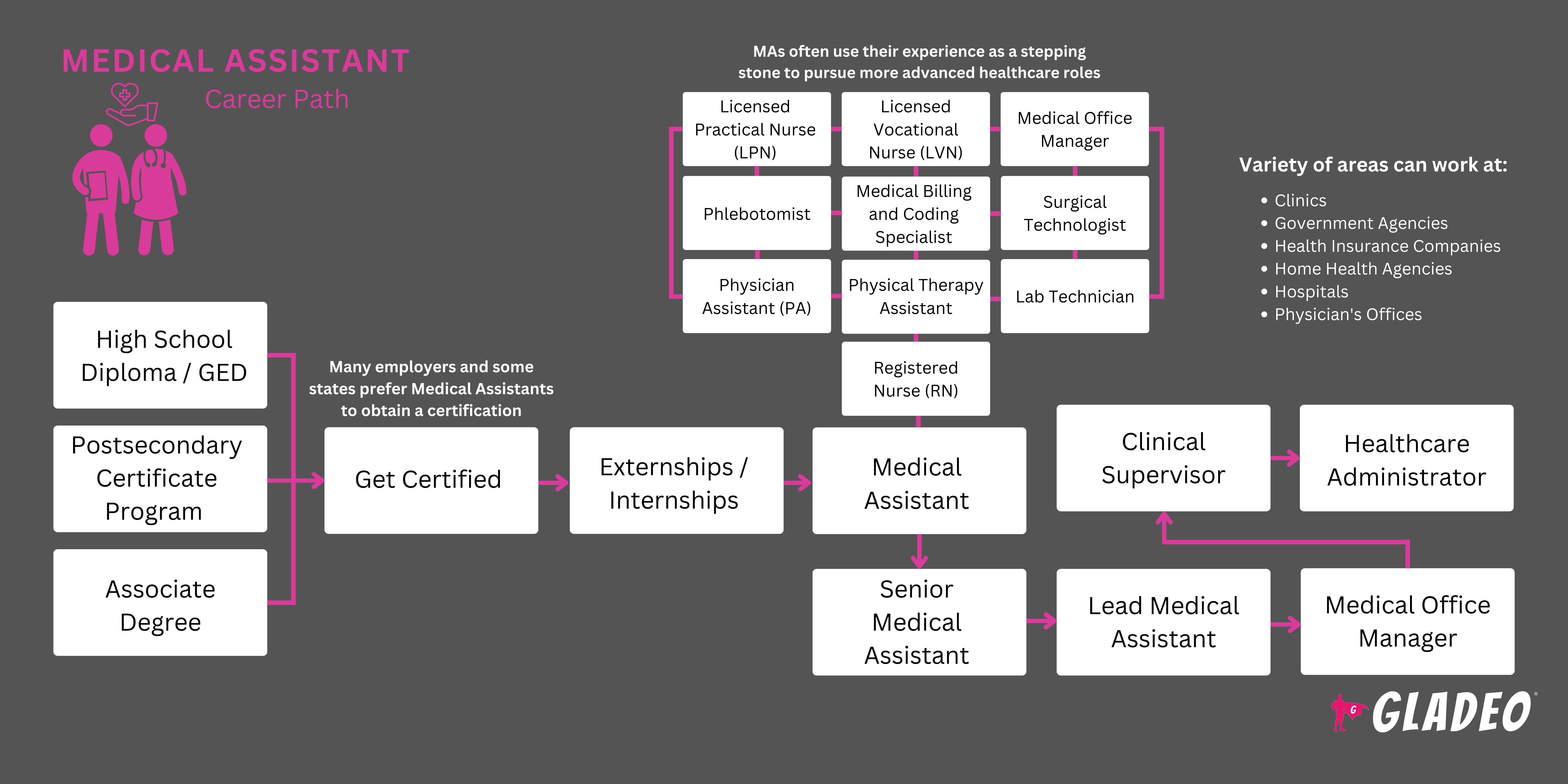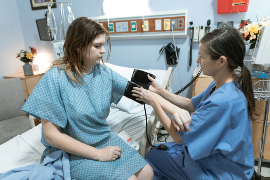스포트라이트
공인 의료 보조(CMA), 카이로프랙터 보조, 임상 의료 보조, 의사 보조, 건강 보조, 안과 보조, 안과 보조, 검안 보조, 외래 수술 보조, 등록 의료 보조(RMA), 환자 치료 기술자
의료 시설은 가능한 한 많은 환자를 치료하는 동시에 각 환자에게 필요한 시간과 주의를 기울이기 위해 효율적으로 일해야 합니다. 그렇기 때문에 의료 보조원(MA)이 투입되어 업무 관리와 프로세스 진행을 돕습니다.
의료 보조원은 개인 클리닉과 병원에서 외래 환자 치료 센터에 이르기까지 거의 모든 환경에서 다른 의료 팀원과 함께 일합니다. 많은 의료 보조원은 족부과, 안과, 심장내과 등의 전문 분야를 전문으로 하기 위해 추가 교육을 받기도 합니다.
일부는 예약, 보험 청구 처리, 기록 유지와 같은 행정 업무에 집중합니다. 다른 사람들은 교육 및 승인에 따라 병력 검토, 활력 징후 측정, 채혈, 약물 투여와 같은 임상 업무를 수행합니다.
2033년까지 거의 백만 개의 고용 기회가 예상되는 의료 보조 직종은 앞으로 몇 년 동안 인기 있는 직업 분야가 될 것입니다!
- 진료 중 환자 지원
- 전문 의료 팀의 일원이 되기
- 다양한 환경의 작업자에 대한 높은 수요
- 전문화 및 경력 발전의 기회
근무 일정
의료 보조원은 파트타임 또는 풀타임으로 근무할 수 있습니다. 교대 근무에는 야간, 주말 또는 공휴일이 포함될 수 있습니다.
일반적인 의무
- 환자 예약을 예약하고 알림 전화 또는 안내를 통해 후속 조치를 취하세요.
- 시험실을 준비합니다. 시험실이 깨끗하고 정돈되어 있는지, 소모품이 구비되어 있는지 확인합니다. 기구와 장비를 소독합니다.
- 환자의 진료 예약을 확인하고, 보험 적용 범위를 확인하고, 기록을 업데이트하세요.
- 환자의 병력 및 혈압, 체온, 체중 등의 활력 징후를 기록합니다.
- 환자가 의사를 만날 준비가 되었는지 확인하여 검사를 준비합니다.
- 검사 및 봉합사 제거나 드레싱 적용과 같은 경미한 시술 중 필요에 따라 의사를 보조합니다.
- 감독하에 지시에 따라 주사 및 약물을 투여하세요.
- 혈액 샘플을 채취합니다. 안전한 취급 및 라벨 부착을 위한 프로토콜을 따르세요.
- 소변 검사나 혈당 모니터링과 같은 기본적인 실험실 검사를 수행합니다.
- 환자 또는 보호자와 함께 치료 계획 및 투약 지침을 검토하세요.
추가 책임
- 전화를 받고 이메일이나 기타 메시지에 답장하세요.
- 환자의 우려 사항을 다른 의료 팀원에게 전달하세요.
- 재고를 관리하고 필요에 따라 소모품을 재주문하세요.
- 환자의 기밀을 유지하고 기록을 안전하게 보호하세요.
소프트 스킬
- 침대 옆 매너
- 동정
- 여유
- 신뢰성
- 디테일 지향
- 공감
- 대인 관계 기술
- 관찰력
- 끈기
- 신뢰성
- 안전 의식
- 건전한 판단
- 강력한 의사 소통 기술
- 팀워크 및 협업
기술 능력
- 일반적인 의료 질환에 대한 지식
- 약속 예약 소프트웨어 관리
- 전자 의료 기록 시스템을 사용하여 환자 기록 문서화 및 유지 관리
- 활력 징후(혈압, 심박수, 체온) 측정 및 기록
- 감독 하에 약물 투여
- 혈액 채취 및 기본 실험실 검사 수행
- 경미한 수술 절차 및 상처 치료 지원
- 심전도 수행
- 위생, 멸균 관행 및 감염 관리에 대한 숙지
- 병원
- 장기 요양 설정
- 외래 환자 센터
- 의사 사무실
- 재활 센터
- 전문 치료 시설
- 치료 부서
- 긴급 치료 시설
의료 보조원은 다양한 환경에서 의료 팀에 중요한 지원을 제공합니다. 중요한 행정 및 임상 업무를 지원하여 환자가 적시에 필요한 치료를 받을 수 있도록 합니다.
의료 보조원은 종종 만성 질환이나 장애가 있는 환자를 보조하며 신체적, 정서적으로 힘들 수 있는 실질적인 지원을 제공합니다. 일반적인 하루 일과에는 시술 보조, 약물 투여, 바이탈 사인 측정, 이동성 운동 보조 등이 포함될 수 있습니다. 이러한 업무를 수행하려면 조직력과 압박감 속에서도 침착함을 유지할 수 있는 능력이 필요하며, 특히 환자의 기분이 좋지 않거나 화가 났을 때 더욱 그렇습니다.
매니저는 업무 환경에 따라 야간, 주말, 공휴일에도 근무해야 할 가능성이 있습니다. 이러한 고된 교대 근무와 개인 생활의 균형을 맞추는 것은 어려울 수 있으며, 번아웃을 피하려면 자기 관리를 위한 시간을 확보하는 것이 중요합니다.
의료 분야, 특히 외래 및 장기 요양 시설에서 MA에 대한 수요가 증가하고 있습니다. 이러한 증가는 부분적으로는 사람들이 더 오래 살면서 만성 질환을 관리하기 위해 더 많은 서비스를 필요로 하기 때문입니다. 동시에 수천 명의 의료 전문가가 은퇴하면서 여러 가지 공백이 발생하고 있습니다. 그렇기 때문에 많은 조직에서 이러한 공백을 메우기 위해 MA를 활용하고 있습니다.
온라인 교육 프로그램이 확대되면서 해당 분야에 진출하고자 하는 근로자들이 보다 유연하고 쉽게 석사 교육을 받을 수 있게 되었습니다. 그러나 학생들은 프로그램이 인증 요건을 충족하는지 확인하는 데 주의를 기울여야 합니다.
의료기사에 대한 높은 수요로 인해 현재 근무하는 의료기사들은 더 긴 시간, 더 많은 환자, 더 큰 책임을 지고 있습니다. 그렇기 때문에 의료진은 업무 소진을 피하기 위해 정신적, 육체적 건강을 잘 관리해야 합니다.
어머니들은 일찍부터 의료 서비스에 관심을 가졌거나 단순히 다른 사람을 돕는 일에 관심이 있었을 수도 있습니다! 가족을 돌보는 간병인으로서 도움이 필요한 사람들을 지원하는 것이 얼마나 중요한지 직접 경험했을 수도 있습니다.
필요한 교육
- 의료 보조원은 고등학교 졸업 또는 이와 동등한 학력이 필요하며 일반적으로 전문학교나 커뮤니티 칼리지에서 고등교육 자격증 프로그램 또는 준학사 학위를 이수합니다.
- 일반적인 코스 주제는 다음과 같습니다:
- 해부학 및 생리학
- 임상 절차
- 의료법 및 윤리
- 의학 용어
- 환자 치료 기술
- 정맥 천자 및 심전도
- 신입 사원은 일반적으로 입사 후 상당한 양의 실무 교육을 받습니다.
- 규모가 큰 고용주는 견습생 또는 사내 의료 보조원 교육을 제공할 수 있습니다.
- 많은 고용주와 일부 주에서는 의료 보조원 자격증을 취득하는 것을 선호합니다:
- 미국 의료 보조원 협회 - 공인 의료 보조원
- 미국 의료 기술자 - 등록 의료 보조원
- 전국 의료진 협회 - 공인 임상 의료 보조원
- 국립 역량 교육 센터 - 국가 공인 의료 보조원
🗸 일부 인증 기관에서는 지원자가 연합 보건 교육 프로그램 인증 위원회 또는 보건 교육 학교 인증 국에서 인증한 프로그램을 졸업해야 한다는 점에 유의하세요.
- MA는 종종 자신의 경험을 디딤돌 삼아 다음과 같은 고급 의료 직무를 수행하는 데 활용합니다:
- 간호사(RN)
- 면허 실무 간호사(LPN)
- 면허 직업 간호사(LVN)
- 의료 사무실 관리자
- Phlebotomist
- 의료 청구 및 코딩 전문가
- 외과 기술자
- 의사 보조(PA)
- 물리 치료 도우미
- 실험실 기술자
- 교육 프로그램은 커뮤니티 칼리지, 직업/기술 학교 및 일부 고등학교 프로그램에서 이용할 수 있습니다.
- 석사 프로그램은 연합 보건 교육 프로그램 인증 위원회(CAAHEP) 또는 보건 교육 학교 인증국(ABHES)의 인증을 받을 것을 권장합니다.
- 근무하려는 주에 대한 요구 사항을 검토하세요.
- 수업료(주내/주외 요금), 할인, 장학금, 강의 제공 옵션(캠퍼스 내, 온라인 또는 하이브리드 프로그램)을 고려합니다.
- 현지 의료 시설에서 실습할 수 있는 옵션을 검토해 보세요.
- 특히 다른 약속과 균형을 맞추는 경우 프로그램 기간과 수업 일정의 유연성을 고려하세요.
- 교수진의 약력과 수상 경력을 살펴보세요. 졸업률, 자격증 시험 합격률, 취업률 통계에 대해 알아보세요.
- 동문 네트워크의 성과를 확인하세요!
- 의료 현장에서 자원봉사를 하며 경험을 쌓고 실무 기술을 익혀보세요.
- 고등학교에서 해부학, 생리학, 생물학, 보건학, 응급처치, 수학, 영어와 관련된 수업을 수강하세요.
- 행정 능력을 키울 수 있는 학교 활동에 참여하세요.
- 진료소, 병원, 요양원 등 의료 환경에서 아르바이트를 구해 실무 경험을 쌓고 인적 자원 관리 능력을 향상하세요.
- 심폐소생술 및 기본 생명 유지 자격증을 취득하여 자격을 강화하고 응급 상황 대응 역량을 강화하세요.
- 의예과 또는 건강 관련 학생 단체에 가입하여 의료 분야의 동료 및 전문가들과 네트워크를 형성하세요.
- 의료계 진로를 꿈꾸는 학생을 위한 장학금 또는 재정 지원 프로그램을 살펴보세요.
- 의료 분야 커리어에 초점을 맞춘 채용 박람회나 취업 박람회에 참석하세요.
의료 분야에서 인턴십을 제공하는 학교 프로그램을 활용하세요. - 의학 용어를 익혀 언어에 익숙해지세요.
- 의료 보조원이 되기 위한 주 또는 잠재적 고용주의 요구 사항을 조사하세요.
- 범죄 경력 조회 또는 약물 검사를 통과해야 할 수도 있다는 점을 명심하세요.
- 현직 의료 보조원과의 정보 제공 인터뷰를 요청하여 그들의 일상 업무에 대해 알아보세요.
- 체크 아웃 의료 보조의 오늘 잡지와 온라인 기사 및 동영상에서 이 직업 분야, 일할 수 있는 환경, 취득할 수 있는 자격증에 대해 알아보세요.
- 향후 취업 참고자료로 활용할 수 있는 연락처 목록(전화번호 또는 이메일 포함)을 관리하세요. 단, 정보를 제공하기 전에 상대방의 동의를 구하세요.
- 이력서 초안을 작성해 두었다가 경력이 쌓이면서 업데이트하세요.

- 공인 교육 프로그램을 이수하고 공인 의료 보조원, 등록 의료 보조원, 공인 임상 의료 보조원 또는 국가 공인 의료 보조원 자격증을 취득하는 것을 고려해 보세요.
- 학교의 프로그램 관리자나 커리어 센터에 취업 지원에 대해 문의하세요.
- 인디드닷컴과 같은 구직 엔진에 이력서를 업로드하세요. 또한 전미 의료 직업 협회와 같은 의료 관련 구인 게시판도 확인해 보세요.
- 의료 전문가와 네트워크를 형성하고 업계 채용 박람회에 참석하세요.
- LinkedIn에서 자신을 홍보하세요. 잠재적 고용주가 지원자의 온라인 활동을 심사하는 경우가 많으므로 소셜 미디어를 전문적으로 관리하세요.
- 다음과 같은 키워드로 이력서를 업데이트하세요:
- 관리 기술
- 임상 지원
- EMR 시스템
- 의료 절차
- 환자 관리
- 바이탈 사인
- 의료 보조 이력서 예시에서 서식, 문구 및 사용할 키워드에 대한 아이디어를 확인하세요.
- 일반적인 면접 질문을 검토하고 모의 면접을 통해 답변 연습을 해보세요.
- 면접에 가기 전에 고용주에 대해 조사해 보세요. 회사의 사명과 가치에 대해 읽어보세요.
- 업계와 관련된 용어와 최신 이슈에 대해 알아보세요.
- 면접을 위해 전문적으로 복장하세요.
- 상사와 커리어 목표에 대해 논의하세요. 상사의 지도와 멘토링, 개선이 필요한 부분에 대한 피드백을 요청하세요.
- 추가 자격증을 취득하세요. 안과 및 족부외과와 같이 수요가 많은 분야를 전문으로 합니다.
- 자비로우면서도 전문적인 태도로 환자와 소통하세요. 환자를 배려하고 일을 제대로 하는 사람으로 평판을 쌓으세요.
- 고용주의 정책과 절차를 연구하여 더 효율적이고 신뢰할 수 있는 기업이 되세요.
- 사용하는 장비와 소프트웨어에 대한 주제별 전문가가 되어 보세요.
- 엄격한 위생 및 위생 프로토콜을 유지하여 의료 환경의 안전을 도모하세요.
- 의사, 간호사 및 기타 의료 팀원과의 관계를 강화하세요.
- 의학 저널과 블로그를 정기적으로 읽거나 최신 의료 관행에 관한 웨비나에 참석하세요.
- 평생 교육 과정과 워크샵을 활용하여 업계 발전에 대한 최신 정보를 얻으세요.
- 회의 진행, 신입 직원 교육, 환자 치료 이니셔티브 조직에 자원하여 참여하세요.
- 사무실 관리자, 의료 관리자 또는 대규모 의료 기관의 감독직과 같은 고급 역할을 위한 교육을 고려하세요.
- 미국 의료 보조원 협회와 같은 전문 단체에 가입하고 참여하세요.
- 성과 검토 시 보여줄 환자 피드백, 효율성 개선 사항, 문제 해결 사례를 기록하여 성과와 성과를 추적하세요.
- 직장 안팎에서 멘토링을 찾아 경험 많은 전문가로부터 인사이트를 얻으세요.
- 다양한 부서 또는 전문 분야를 교차 교육하여 활용도를 높이세요.
- 관리직에 관심이 있다면 의료 행정학 학사 학위를 취득하는 것도 고려해 보세요.
- 환자를 옹호하고 환자가 자신의 치료 계획을 이해하도록 합니다.
- 필요한 경우 더 많은 기회가 있는 지역으로 이동합니다.
웹사이트
- 보건 교육 학교 인증국
- 미국 의료 보조원 협회
- 미국 의료 인증 협회
- 미국 의료 기술자
- 연합군 건강 교육 프로그램 인증위원회
- MedicalAssistantSchools.com
- 국립 역량 테스트 센터
- 전국 건강 경력 협회
책
- Kinn의 의료 보조원: 응용 학습 접근법(Brigitte Niedzwiecki RN MSN RMA 및 Julie Pepper BS CMA 저)
- CMA 학습 가이드 2024-2025: 뉴스톤 시험 준비의 완전한 AAMA 리뷰
- 의학 용어: 의학 용어를 암기하고, 발음하고, 이해하는 가장 효과적인 방법, S. Meloni M.D. 및 M. Mastenbjörk M.D. 저.
의사는 의료계에서 중요한 역할을 담당하지만 다른 의료 직업에 비해 급여가 높지는 않습니다. 관련 진로에 관심이 있는 학생에게는 다음과 같은 옵션이 있습니다:
- 치과 보조
- 건강 정보 기술자
- 가정 건강 또는 개인 관리 도우미
- 면허를 소지한 실무 및 직업 간호사
- 면허 실무 간호사(LPN)
- 의료 청구 및 코딩 전문가
- 의료 기록 전문가
- 조산사 간호사
- 간호 보조 및 질서 유지
- 영양사
- 작업 치료 보조 및 보좌관
- 검안사 도우미
- 개인 피트니스 트레이너
- 약국 기술자
- Phlebotomist
- 물리 치료 도우미
- 의사 보조원
- 간호사(RN)
- 수의사 보조
뉴스 피드

주요 채용 정보

온라인 과정 및 도구








